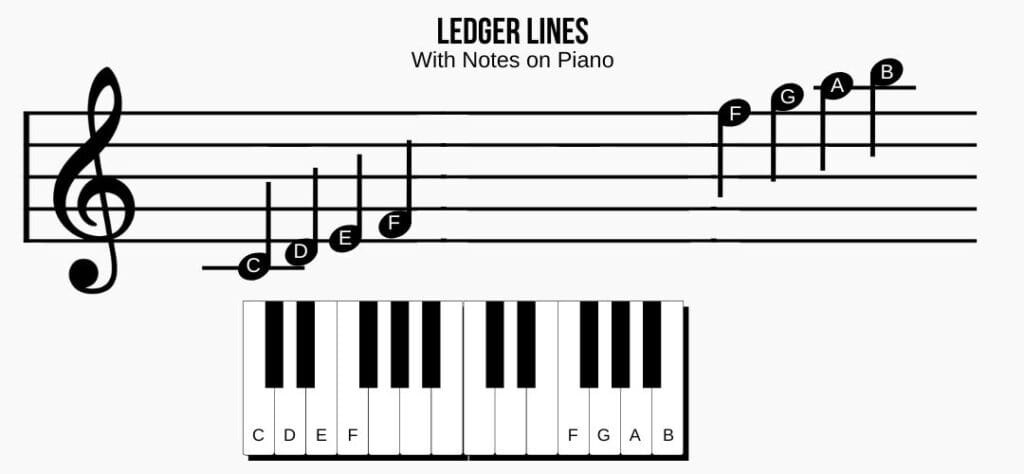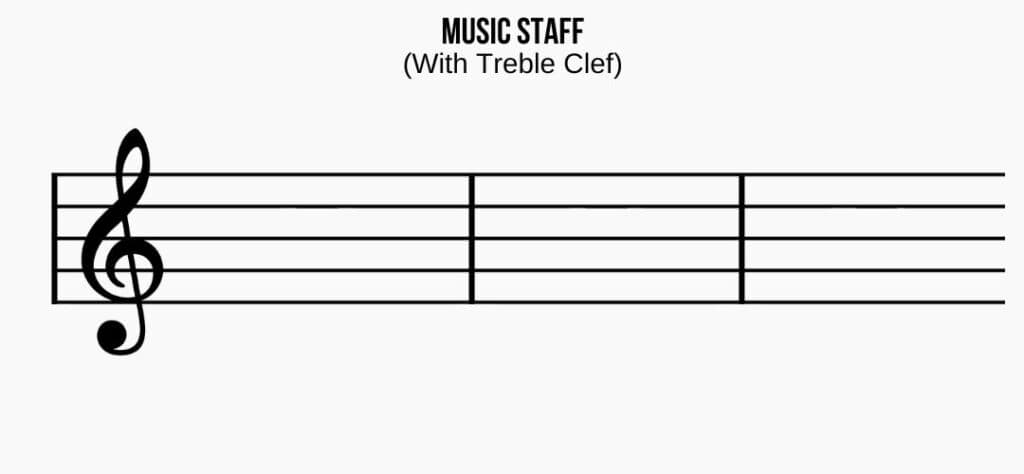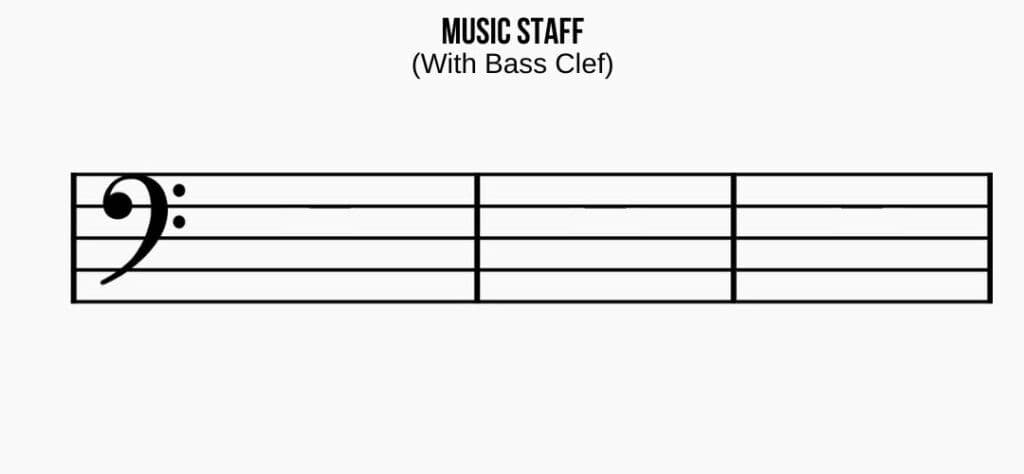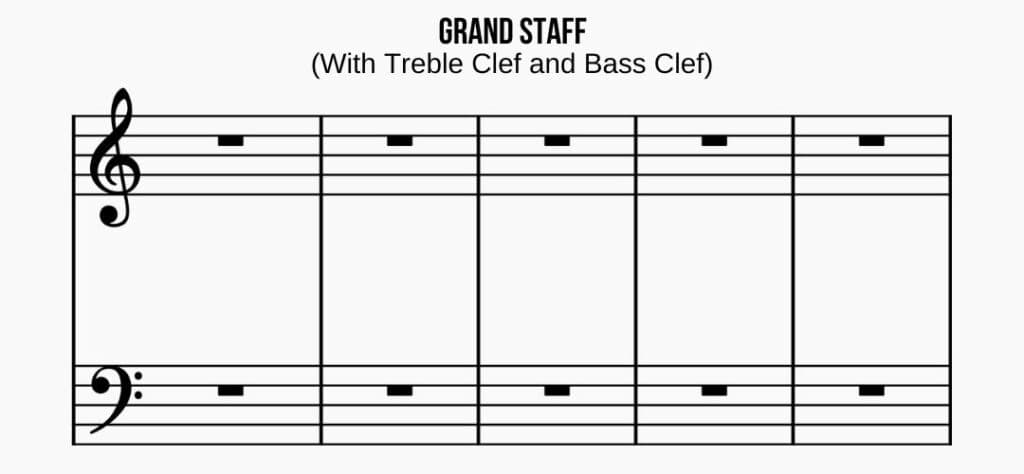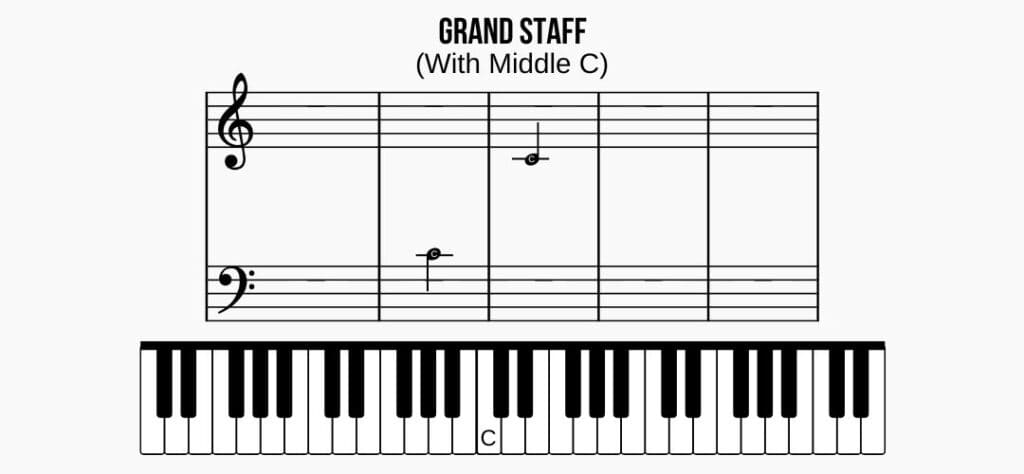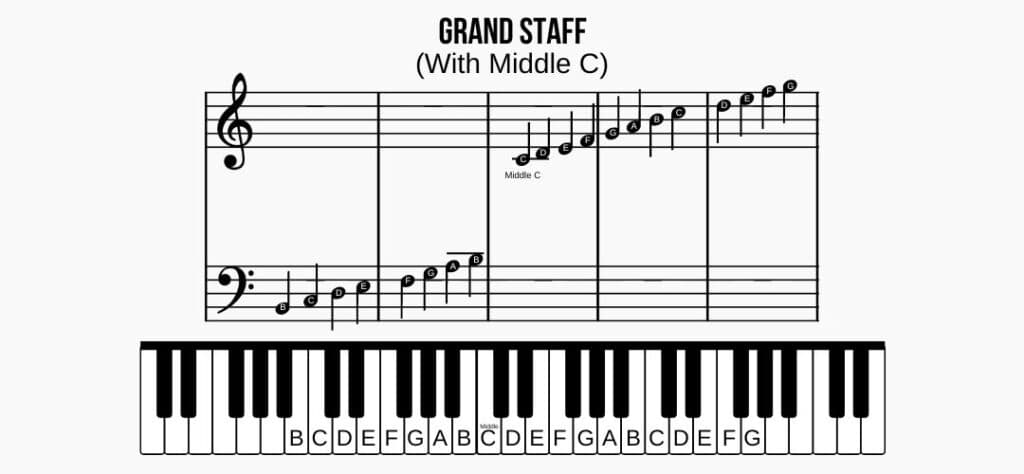In this first lesson, we’ll dive into some of the basic elements of music theory: the staff, ledger lines, clefs, and the grand staff. By the end, you’ll have a solid foundation to start reading and playing music with confidence.
Understanding the Music Staff
The musical staff is where it all begins.
Think of the staff as the blank canvas on which music is written.
The staff is made up of five lines and four spaces.
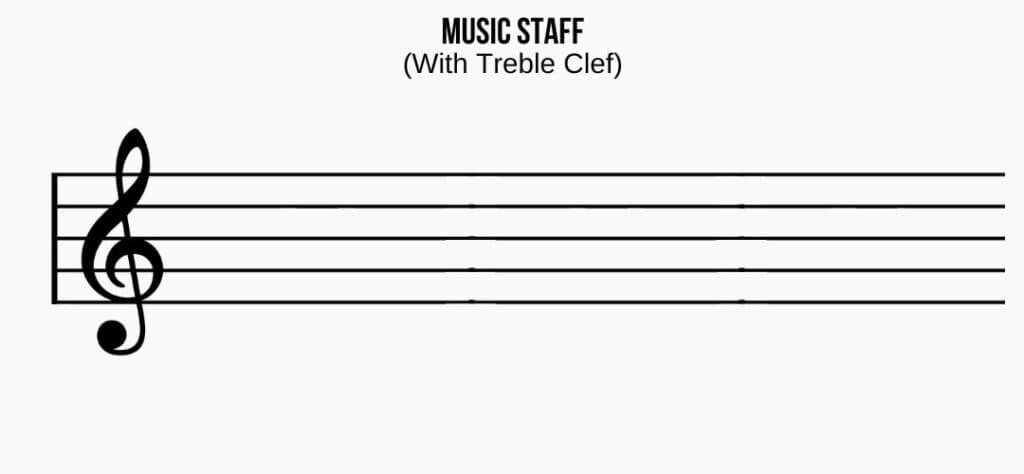
Each line and space represents a different musical note, and the position of the note on the staff tells you which note to play or sing.
The musical notes on the staff tell you what sound to make. They may include a musical symbol or other letters and markings – but that will come later in the music theory course.
The bottom line of the staff represents a low note, and as you move up the staff, the notes get higher. They are numbered from bottom to top with the bottom line as the first line and the top line as the fifth line.
This simple structure allows musicians to quickly see what musical notes to play and how high or low they should be.
Each line and space on the music staff represents a white key on a piano.
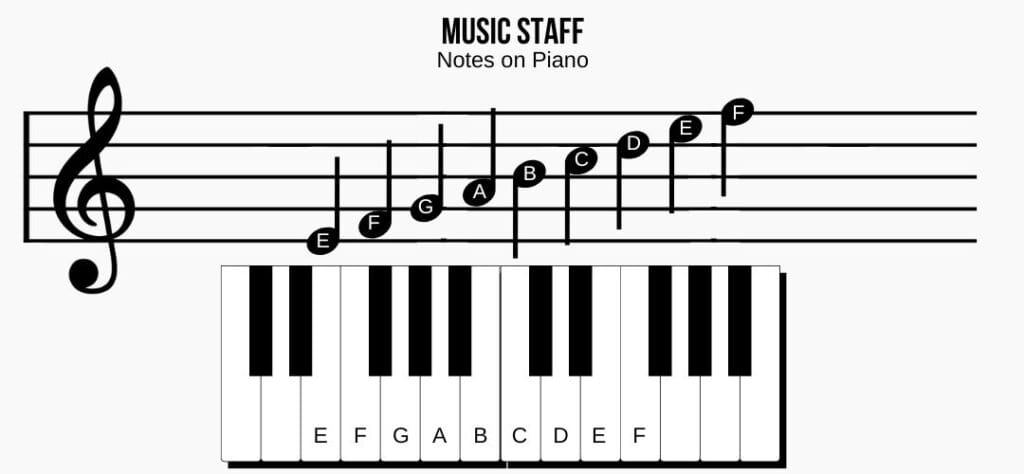
The staff is the backbone of written music, and learning to read it is the first step in understanding music theory.
Once you know how to read the notes on the staff, you can start playing or singing the music that’s written there.
Note placement can be confusing at first but the music staff makes it come naturally over time with practice.
Fun Fact: While we use the five line staff today, the four line staff was a major step in musical notation and was primarily used for Gregorian chant to fit the vocal range of monks singing in the monasteries.
What Are Ledger Lines?
But what happens when the notes are too high or too low to fit on the staff?
That’s where ledger lines come in. Ledger lines are short, horizontal lines that are added above or below the staff to extend its range. These extra lines allow composers to write notes that are outside the normal range of the staff.
For example, if a note is too high to fit on the staff, a ledger line is added above the staff to place the note on. The same thing happens for notes that are too low—they get a ledger line below the staff.
Ledger lines are like a musical ladder, letting notes climb higher or lower than the staff allows. Even though they might seem tricky at first, once you get used to reading ledger lines, they become just as easy to understand as the notes on the regular staff.
Ledger lines can be necessary when there are multiple notes played at the same time on one staff.
Role of the Treble and Bass Clef in Music Notation
Clefs are another important part of music notation.
A clef is a symbol at the beginning of the staff that tells you which notes are represented by the lines and spaces. Without a clef, you wouldn’t know what notes to play! The clef sets the stage for the music that follows, showing you where the notes fall on the staff.
Treble Clef
The treble clef, also known as the G clef, is one of the most common clefs. It’s used for higher-pitched notes, like those played by a violin or sung by a soprano. The treble clef wraps around the second line of the staff, and this line represents the note G. Once you know where G is, you can figure out all the other notes on the staff.
Bass Clef
The bass clef, or F clef, is used for lower-pitched notes, like those played by a bass guitar or sung by a bass singer. The bass clef has two dots that surround the fourth line of the staff, which represents the note F. Just like with the treble clef, once you know where F is, you can figure out the other notes on the staff.
Other Clefs: Alto, Tenor, and Percussion Clef
While the treble and bass clefs are the most common, there are other clefs too, like the alto and tenor clefs. These clefs are used for instruments that play in a middle range, like the viola. The alto clef is centered on the middle line of the staff, which represents the note C. The tenor clef is similar, but it’s placed higher on the staff.
Each clef serves a purpose, helping musicians know exactly which notes to play or sing, no matter what range their instrument or voice is in.
Learning the treble and bass clefs will give you a huge range to work with when playing with both your left hand and right hand at the same time.
The Grand Staff: Bringing It All Together
Now that we’ve covered the staff, ledger lines, and clefs, it’s time to talk about the grand staff.
The grand staff is like a combination of the treble and bass clefs, and it’s used to notate music that spans a wide range of pitches.
You’ll often see the grand staff in piano music, where one hand plays the higher notes on the upper staff with a treble clef and the other hand plays the lower notes on the lower staff with a bass clef.
The grand staff consists of two staves: the top staff has a treble clef, and the bottom staff has a bass clef.
These two staves are connected by a brace on the left side, and they work together to show a full range of notes.
Middle C, which is the note right in the middle of the piano, sits between the two staves—on a ledger line just below the treble staff or just above the bass staff.
Using the grand staff allows composers to write music that covers the entire range of the piano or other instruments with a wide range. It’s like having the best of both worlds, with the high notes on the treble staff and the low notes on the bass staff.
Note: Sometimes both staves will show the same clef. These clef combinations could include two treble clefs or two bass clefs.
For example, a piece of music might have two treble clefs on both staves when it’s written for an instrument or a voice part that primarily plays or sings in a higher range (which can happen often in classical music).
This is common in piano music where both hands are playing notes in the treble range, or in music for other instruments like the harp or for vocal duets where both parts are in the treble range. Using two treble clefs helps keep all the notes within the comfortable reading range of the treble staff, making the music easier to read and play.
Fun Fact: An organ with a pedalboard uses a grand staff that is made up of three staves!
How to Read Music on the Grand Staff
Reading music on the grand staff might seem tricky at first, but once you get the hang of it, it becomes much easier. The key is to remember that the treble staff and bass staff are connected. The notes on the treble staff are higher in pitch, and the notes on the bass staff are lower.
Start by finding Middle C, which acts as the bridge between the two staves. Once you know where Middle C is, you can find other notes around it. For the treble staff, remember that the notes move up the staff in alphabetical order: C, D, E, F, G, A, B, and so on. For the bass staff, the notes also move up in alphabetical order, but they start from a lower pitch.
When reading music on the grand staff, your hands usually work together—one hand plays the notes on the treble staff while the other hand plays the notes on the bass staff. This allows you to play music that covers a wide range of sounds, all written neatly on the grand staff.
Practical Tips for Mastering the Basics
Learning to read music can feel like learning a new language, but with practice, it becomes second nature. Here are some practical tips to help you master the basics of the staff, ledger lines, clefs, and the grand staff:
- Start Slow: Don’t rush when you’re learning to read music. Take your time to understand each note and where it belongs on the staff.
- Practice Regularly: Just like with any skill, practice is key. Spend a little time each day reading music, even if it’s just a few notes at a time.
- Use Mnemonics: Mnemonics can help you remember the notes on the staff. For example, in the treble clef, the lines spell out “Every Good Boy Does Fine,” and the spaces spell “FACE.”
- Visualize the Keyboard: If you’re learning piano, visualize where the notes are on the keyboard as you read them on the staff. This can help you make the connection between what you see and what you play.
- Stay Patient: Learning to read music takes time, so be patient with yourself. Celebrate your progress, and remember that every bit of practice helps.
Conclusion: The Foundation of Musical Literacy
Understanding the staff, ledger lines, clefs, and the grand staff is the foundation of musical literacy. These tools allow musicians to read and play music, bringing the notes on the page to life. Whether you’re just starting out or you’ve been playing for a while, mastering these basics will open up a world of musical possibilities.
By taking the time to learn and practice these elements of music theory, you’ll be able to play a wide range of music, from simple melodies to complex compositions. The more you understand about how music is written, the more you can enjoy playing and creating music of your own.

